The Bernina Express: Europe’s Highest Alpine Train
With my head out the window, I breathed in the alpine air as the Bernina Express crossed from Italy into Switzerland, climbing the edge of the Valposchiavo on our 37-mile journey to St. Moritz. Over the next two hours, this train, a UNESCO World Heritage Site, would take me through 55 tunnels and across 196 bridges, over Europe’s highest alpine crossing by rail
• • •
My day started with a 6:40 am alarm in Milan.
My intention had been to spend the night farther north, but a 24-hour train strike halted those plans.
So, I booked a hotel near the train station, and instead of dinner in Colico on Lake Como, I enjoyed a cocktail and small aperitivi on the rooftop terrace overlooking Milano Centrale and the Piazza Duca D’Aosta.
The next morning, I quickly showered, packed, checked out of my hotel, and was in a northbound that pulled out of the station — all in just 40 minutes after that morning alarm clock.
The train ran north along the eastern shore of Lake Como. I was concerned, being that it was the morning after a 24-hour strike, that this train would be packed.
Far from it.
I had much of the car to myself, enough that I could move back and forth to snap photos and videos, at least when rows of trees were not blocking my view of the lake.
Carved by glaciers 10,000 years ago, the Y-shaped Lake Como is Europe’s deepest outside of Norway.
Five days earlier, I had had dinner on the opposite side of the lake as part of my southbound journey. This morning, I saw the lake from a different perspective — and in daylight — framed by the Bergamo Alps.
At Colico, the train bears east, running parallel to the Adda River through the long Valtellina, which, in 1902, became home to the world’s first electrified main line railway.
Today, this region may be more known for food and wine than for the rail line on which I was currently traveling. Looking high above the valley, I could see multiple terraces of vineyards, tiny narrow patterns crisscrossing the steep slopes. These were likely Nebbiolo grapes, I would later read, and the wines they would eventually produce are — similar to the valley itself — largely unknown to the world, as approximately 80% of the wine produced here is consumed within a 100-mile radius.
At Sondrio, track work ahead meant that I had to step off the train and board a bus. The bus was modern and comfortable, with every amenity except an outlet to charge my phone.
Within 40 minutes, we were in Tirano, and I had about a half hour to spare before the 11 am departure of the Glacier Express. I grabbed a quick double espresso — Italian style, standing at a counter — and purchased some Bernina Express souvenirs before walking down the platform alongside my train.
It was only then that I remembered having read what would become one of the most valuable tips of this journey: If you have a first-class ticket, which I did, go to the first rail car, and there is a good chance the driver of the train will raise the curtains separating the passenger compartment from the navigation cab, giving a panoramic view.
Sure enough, as I settled into the space, the driver came aboard and said he would open up the shades after we pulled out of Tirano.
I shared the small first-class space with a retired couple from Australia who were in the middle of a six-week “bucket list trip” that would include Dubai, the Amalfi Coast, Venice, a cruise on the Dalmatian coast — and this trip on the Bernina Express, up to St. Moritz and back in a day.
The Bernina Express runs along the streets of Tirano, elevation 1,407, passing by the 16th-century Santuario della Madonna di Tirano before its grand and elegant ascent through the Alps.
The first of many architectural and engineering marvels on this route appeared right away, the nine-arched stone Brusio Spiral Viaduct. We ran under one of the 115-year-old arches, twisted in a 360-degree spiral and, before I knew it, we were climbing the bridge, gaining 32 feet in elevation over the course of 360 feet.
Being in the first car with the ability to open the windows gave us a great view of the back of the train as we twisted up and over the viaduct on our ascent above the Valposchiavo.
A few minutes later, we approached Miralago, elevation 3,163 feet, on the western shore of Lago de Poschiavo.
We had only been on the train 23 minutes, and we had already ascended more than 1,700 feet.
With the lake behind us, we began running along the Poschiavino River, as we approached the town of Poschiavo. This town of 3,516 people — and ten Swiss Heritage sites of national significance — is widely recommended as a stopover. While my rail pass afforded me the opportunity to step off and on as I pleased, I was eager to continue the journey in this front-facing rail car with my new Australian friends, drop my bags at my destination, and then backtrack, unencumbered.
I had been looking at a forecast that showed a 50 percent chance of rain every day, but I saw only blue skies on my trip. I cannot imagine what this must look and feel like in the winter, with the red cars against a snowy landscape. This being September, I could keep the windows open in our train car, only mildly annoying an older German couple who boarded recently and folded their arms as if to say they were chilly.
Soon we were no longer in the valley, but hugging the side of a mountain looking down on the town of San Carlo, just north of Poschiavo. The Australian couple and I took turns at windows, shifting from one side of the train to the other as the train turned as well, plugging in our phones for a minute or two at a time to keep our batteries from running out.
The Bernina Express is known for its panoramic windows that go above the sides of the train cars and bend into the ceilings. Tony Hiss, longtime New Yorker writer and author of several books that inspired my own project on rail travel, recently penned a piece in Railway Age about this route. It is well worth reading in its entirety. Regarding the panoramic cars, he writes:
On the Bernina line, the windows are more like two-thirds of an American wraparound windshield turned 90 degrees to point at the sky, curved at the top to reach uninterruptedly into the roof. There are five facing pairs of these windows in first-class Bernina Express panorama cars, seven in second-class. Each car is only eight and two-thirds wide. The effect is like sitting inside a small, slender Gothic chapel that has become capable of motion.
And as Hiss points out, there is more to appreciate here than the sights. This line is an engineering marvel:
The track alignment embraces its steep mountain landscape rather than erasing or displacing it, celebrating, not severing, every contour change, and resting so lightly on the ground it seems to leave behind only a whisper of its presence instead of carving scars that don’t heal.
The neighboring Albula Railway, on the north side of the same peaks and completed only seven years earlier, was built for steam engines, which need to stay fairly level as they move. That line relies on tall arched viaducts and magnificent curved and even spiral tunnels tucked into the mountains themselves to keep the ascents gradual—precision tunneling was the great engineering innovation of the pre-electrification generation.
Whereas on the electrified Bernina line, it was possible to use lighter-weight equipment that can exuberantly twist around tighter turns and negotiate 7% grades, twice as steep as any on the Albula Line
An hour and ten minutes into the journey, we reached Alp Grüm, 6,860 feet above sea level. We were now in German-speaking Switzerland, in a town not connected to a network of roads. From here, one can look down into the Val Poschiavo, or up at the 2-mile-long Palü Glacier.
It was just past noon, and neither the Australian couple nor myself had eaten yet. I left Milan in a hurry, and had little interest in a sweet pastry in Tirano. They had driven to Tirano and not given themselves enough time for breakfast, and no food was served on the train.
I was quite comfortable with just my double espresso, but they were eager to eat, and so they hopped off at Alp Grüm to eat at the restaurant adjacent to the train station. I would have a beer at the same spot several hours later after a 3-mile walk.
The next stop was supposed to be just seven minutes away. But these Swiss trains do not always run on time. The Bernina line is a single track for much of the route, and we often had to wait in double-tracked spots for an oncoming train to pass. We waited at least 10 minutes between Alp Grüm and Ospizio Bernina.
As I stared up at the Palü Glacier, I could not think of a better place to be delayed.
When we started moving again, we skirted the shore of Lago Bianco, a pale green reservoir nearly two miles long. Soon we were pulling into Ospizio Bernina, which, at 7,392 feet, is the highest train station in Europe, and the highest point on the Bernina Express line. In 2 hours and 20 minutes, we had gained nearly 6,000 feet in elevation, on a train line built more than a century ago.
Here, I had a real sense of remote isolation, similar to how I felt while traveling through northern Norway by train. The landscape, while beautiful, was bleak, with sparse vegetation, and few signs of civilization. It was difficult to believe that I was just an hour away from the glitzy resort of St. Moritz.
Shortly after leaving Ospizio Bernina, we passed a marker noting that any water falling on one side would eventually make its way to the Mediterranean Sea via the Poschiavino, Adda and Po rivers, while water falling on the other side would make its way to the Black Sea via the rivers Inn and Danube.
Beyond this point, the train ran alongside a roadway for the last nine miles to Pontresina — making me appreciate even more the previous stretches of rail where there were no roads in sight.
I requested a stop just before Pontresina, as it was closer to the Hotel Steinbock, where I was staying.
After checking in and dropping my bags, I walked to the Pontresina station for a train back to Ospizio Bernina. From there, I began walking south, along the Lago Bianco, following a mostly-well-marked dirt and gravel path for three miles toward Alp Grüm.
About every 10 to 20 minutes, I would pass a fellow walker or cyclist, a comforting assurance that I was not alone here in this barren, high-altitude mountain pass.
A dam marked the end of the Lago Bianco, and signs continued to point me in the right direction, over some small hills, at one point coming face to face with a handful of mules.
The barrenness soon turned to forest. Not knowing what could be in the trees gave me a sense of unease, as did the realization that I was moving at a good clip at a much-higher altitude than I am used to, without any substantial time to adjust to the thinner air.
I checked Google maps frequently to confirm I was on the right track.
Thirty minutes to go.
Fifteen minutes to go.
And then —
A massive valley unfolded underneath me.
I looked over a rail, and I could see the entire Valposchiavo, including a train far far below me. How could the station be that far away? I was supposed to be just a few minutes from it.
I was worried and confused for a moment, not realizing at the time that I was looking at a train several stations down the line, and yet it appeared to be right underneath me.
Before I could get to the Alp Grüm station — which really was just a five-minute walk downhill — I was greeted by the Casa Alpina Belvedere, a small hotel and restaurant overlooking the valley. People sat outside enjoying drinks on what appeared to be the edge of a cliff.
I had a small beer, took several photos and videos, and continued that last few minutes downhill to the Alp Grüm station.
There I had one more beer while staring up at the Palü Glacier as the sun sank behind the mountain, offering an even clearer view of the waterfalls flowing from the glacier.
I rode back to Pontresina, again on the Bernina Express, admiring the Lago Bianco and the Alps of the Bernina Pass, this time in twilight.
The next day, I would continue to St. Moritz, Chur and Zurich, with a slight bus detour to set foot in Lichtenstein, before flying home to New York City.
To anyone looking for a scenic rail trip in Europe, know that this ride will exceed your expectations.
Do you have a favorite rail route in Europe? Let me know in a comment below.

































